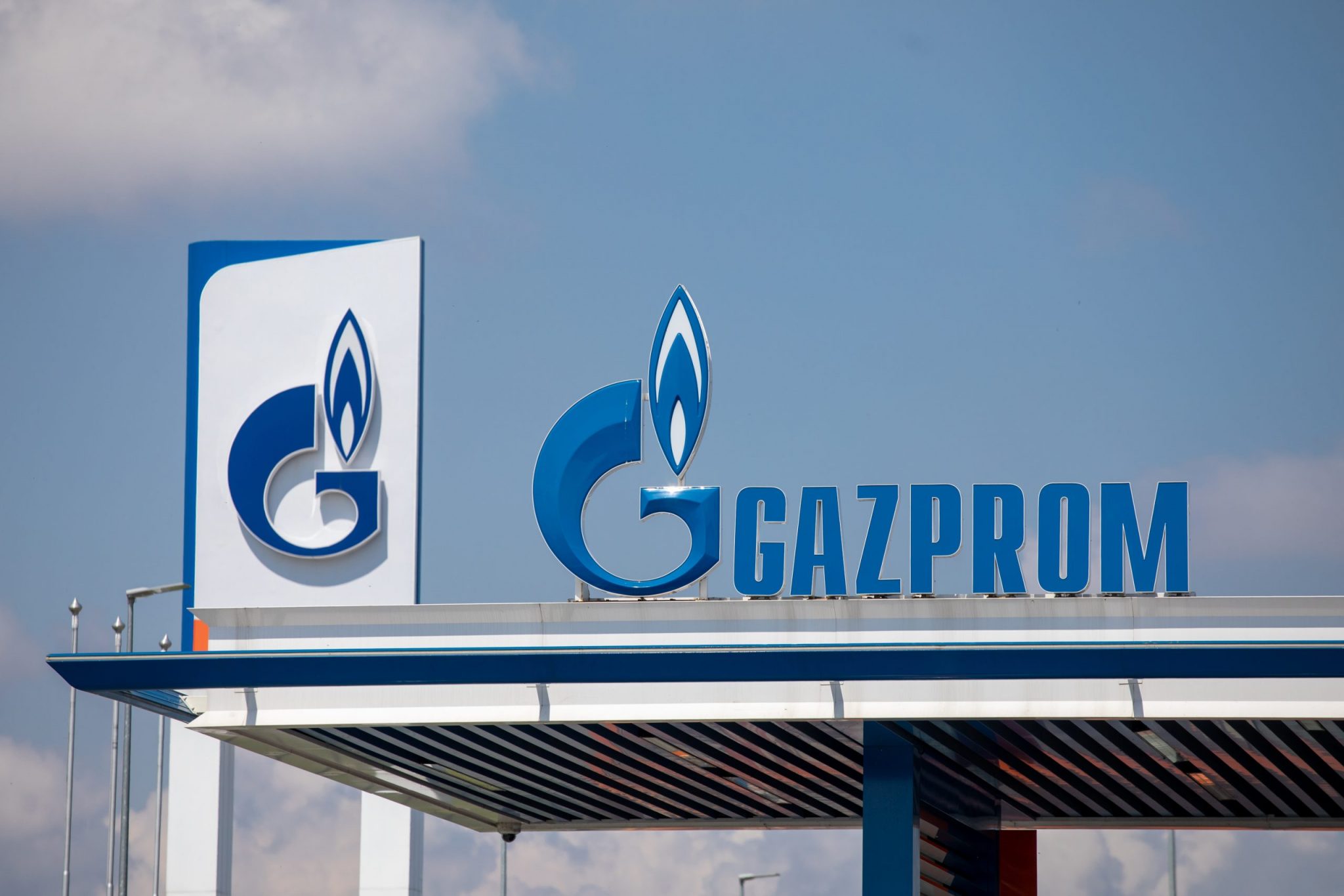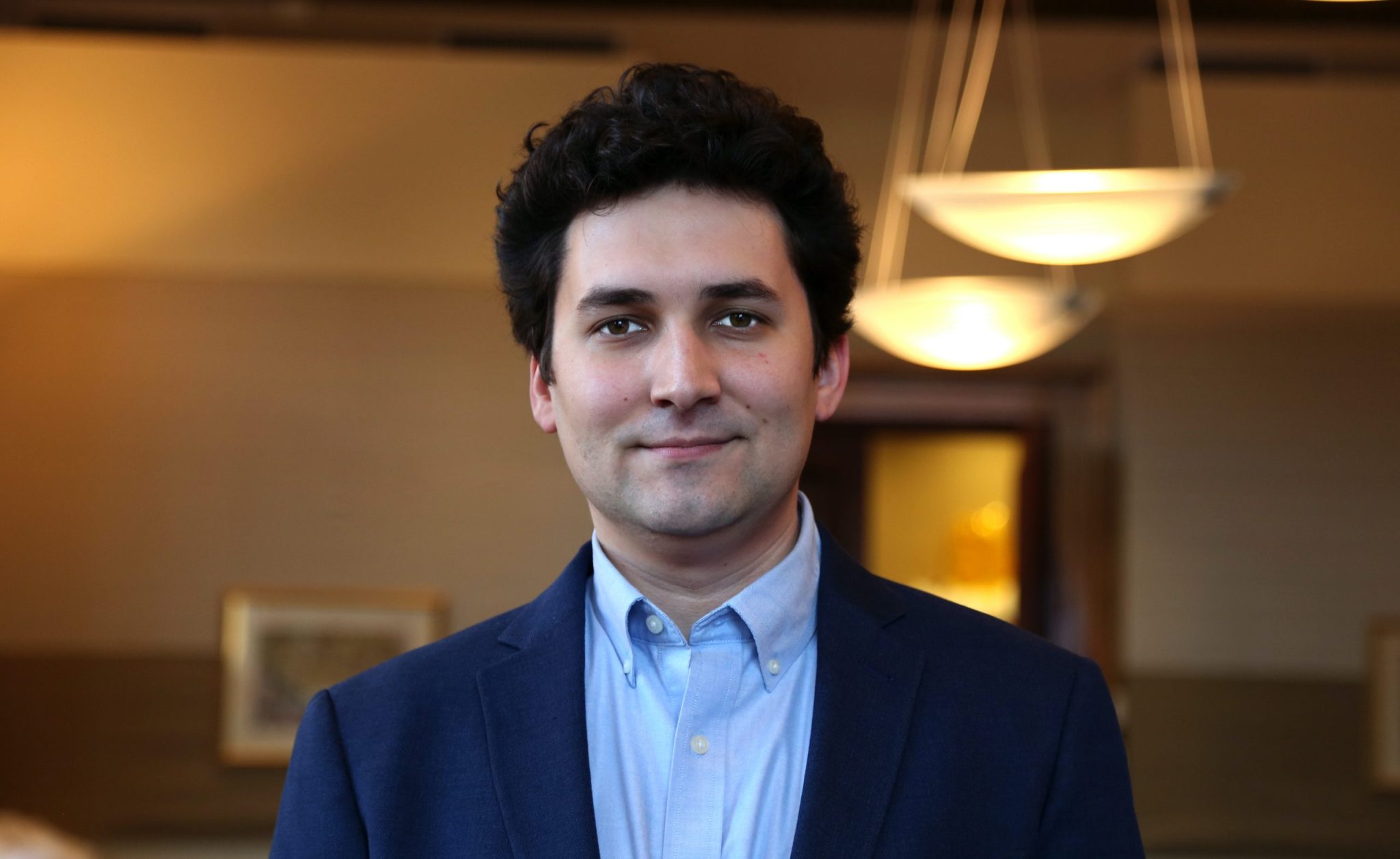This report highlights and analyzes key trends and takeaways from data collected by the Hamilton 2.0 dashboard during the previous month. Unlike ASD’s weekly Hamilton reports, which analyze the main topics and themes promoted by monitored Russian and Chinese actors and entities, this report focuses on the specific Russian, Chinese, and Iranian accounts, outlets, and pieces of content that received the most engagement during the studied period. The report analyzes data collected on Twitter, YouTube, Facebook, and state-sponsored websites. A complete list of monitored accounts and outlets and the methodology behind the dashboard can be found on ASD’s methodology and FAQs page.
Top Takeaways
- Russian state media and diplomatic accounts received 13 percent fewer retweets and 15 percent fewer likes in July than in June. However, Ahi les Va, an RT-affiliated program that we dive into in a separate blog post, stood out for its significant growth. Ahi les Va was the fastest growing media account on both Twitter and Facebook in July, which it was largely able to accomplish by circumnavigating platform bans. As more platforms label Ahi les Va’s accounts, its growth will likely stagnate.
- Western influencers who are sympathetic to China’s narratives were among the most retweeted accounts by Chinese diplomats and state media in July, when looking at accounts outside of China’s propaganda apparatus.
- The Twitter account for Iran’s lead nuclear negotiator saw substantial growth as Tehran and Washington continued to discuss reviving a nuclear deal. Iranian state media’s most popular tweets accused Ukraine of violating the rights of journalist covering Russia’s invasion.
Russia
Twitter Metrics
This section analyzes the top accounts affiliated with and outputs from Russian state media and diplomatic/government Twitter accounts in July 2022. Non-English Tweets are displayed in English using Microsoft’s Translator API. Engagement metrics are determined using Twitter’s public API and are up to date as of early August 2022.
In total, monitored Russian accounts tweeted 69,834 times in July. Those Tweets were retweeted and liked, respectively, 787,986 and 2,384,411 times. That’s 9 percent less tweets, 13 percent less retweets, 15 percent less likes than in June.
Most Retweeted Accounts
The following charts display the most retweeted Russian state media and Russian diplomatic/government accounts during the past month. Favorites and total tweets are also displayed.
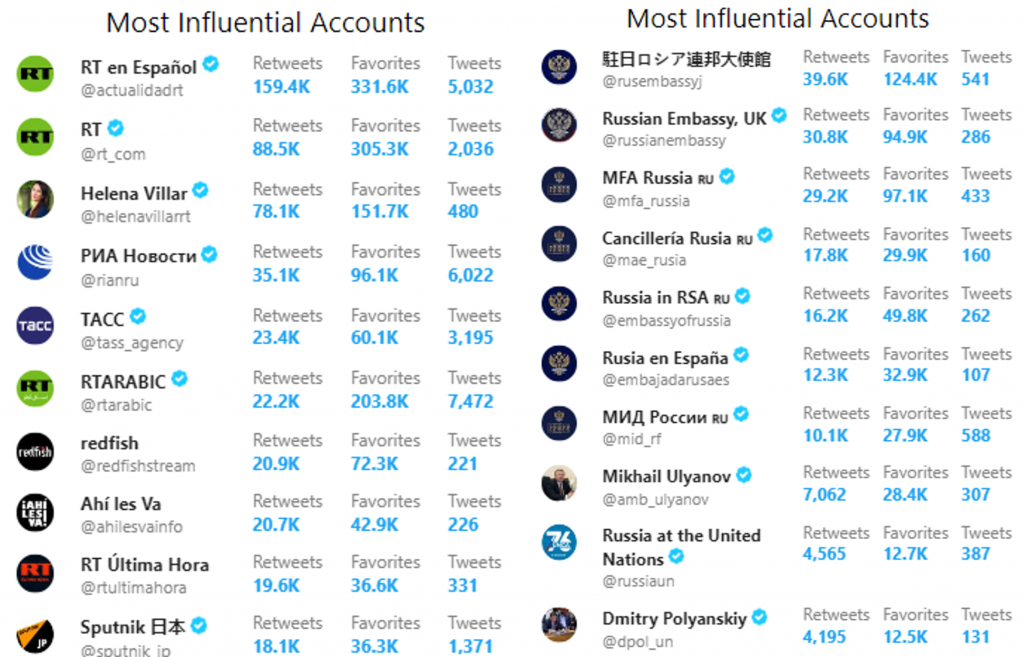
Figure 1: The most retweeted and liked Russian state media (left) and diplomatic/government accounts (right) in July 2022.
In July, Russia’s most influential state media account, RT en Español, continued its downward trend, earning 32,000 fewer retweets and 57,500 fewer likes than it did throughout the previous month. Several top accounts, though, held steady or gained engagements, including the accounts for RT, RIA Novosti, and Tass. RT en Español correspondent Helena Villar saw the biggest gains. She earned 20,400 more retweets in July than in June, showcasing how individual journalists can build their reach even as their outlet declines.
Russia’s Japanese Embassy, which is consistently the most popular diplomatic account, continued to come down from its high early-war engagement metrics. In July, it received 10,800 fewer retweets and 25,200 fewer likes compared to the previous month. The Ministry of Foreign Affairs’ account also earned around 10,000 fewer retweets. The UK Embassy received around 3,000 more retweets from June to July, despite having sent out a tweet that violated platform policies by calling for the “humiliating death” of Ukrainians in July.
Most Followers Gained
The following charts display the state media and diplomatic/government accounts with the largest change in followers from July 1 to July 30, 2022.
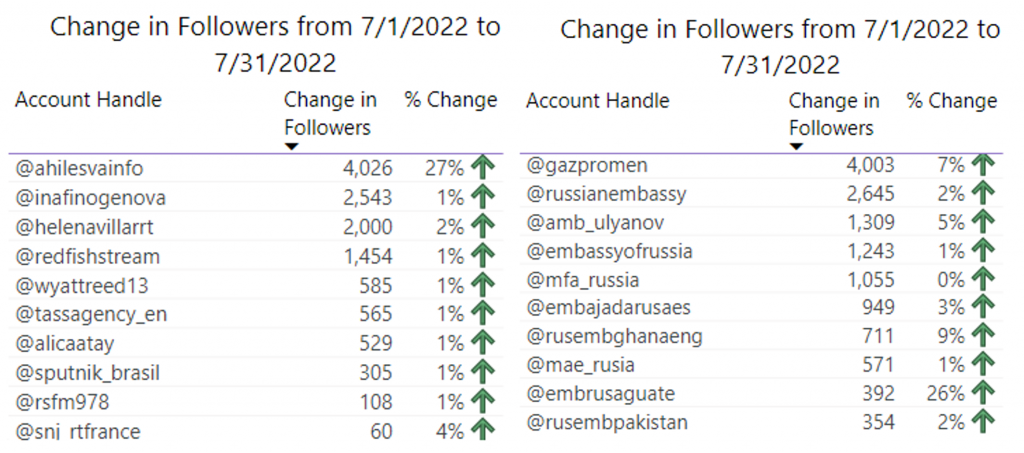
Figure 2: The Russian state media and diplomatic/government accounts with the largest change in followers in July 2022.
Even as RT en Español’s account loses its reach, accounts connected to its programs and correspondents continue to grow. The three fastest growing state media accounts in July were all associated with RT en Español. The account for its program Ahi les Va added 4,026 followers, making it the fastest growing media account. Ahi les Va created its account in April to circumvent platform bans that were imposed in February, but Twitter labeled the account as state media toward the end of July, which will likely slow its growth going forward. Ina Finogenova, who used to host Ahi les Va, saw the second biggest gain on the state media side, followed by the RT en Español correspondent Helena Villar.
The ten fastest growing diplomatic accounts added more followers in July than the ten fastest growing state media accounts, which underscores both the emerging importance of diplomatic messengers and the impact of Twitter’s restrictions on Kremlin-directed media. The five fastest growing diplomatic accounts in July tweet in English, which contrasts with the growth of Spanish-language accounts on the state media side.
The English-language account for Gazprom added the most followers on the government side, bringing in more than 4,000 new followers. This increase can likely be credited to growing interest in the state-directed gas giant as its energy resources are being used to blackmail European states into easing sanctions on Russia. The account for Russia’s Embassy in the UK, which is one of the country’s most aggressive accounts, tacked on 2,645 new followers.
Most Mentioned Countries
The following chart displays the countries most mentioned in Tweets during the past month. Special territories and regions (for example, Hong Kong and the EU) are included as individual entities in the country data. The chart aggregates all mentions of a country, including alternative country names, under that country’s official name (for example, mentions of US, USA, U.S., and America are all included in tabulations for the United States of America).
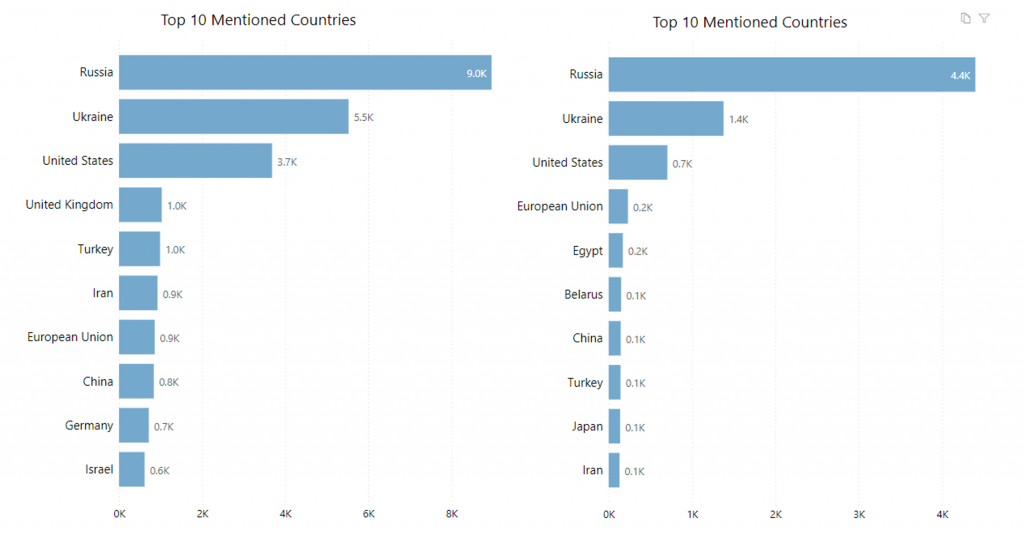
Figure 3: The most mentioned countries in tweets from Russian state media (left) and diplomatic/government accounts (right) in July 2022.
As usual, Russia, Ukraine, and the United States were the three most mentioned countries by both state media and diplomatic accounts. On the state media side, the United Kingdom was the fourth most mentioned country, which reflects the volume of attacks levied at UK Prime Minister Boris Johnson after he announced his intention to resign. Kremlin-backed outlets didn’t pay a similar amount of attention to Japan after the assassination of its former prime minister Shinzo Abe, who was generally seen as open to working with Russia. Japan, though, was a top ten most mentioned country on the diplomatic side, along with a range of Russian partners, including China, Iran, and Belarus.
Most Retweeted Accounts
The following charts display the accounts that have been retweeted most often by accounts monitored on the dashboard during the past month. The first chart displays the monitored accounts most retweeted by other monitored accounts (for example, a diplomatic account retweeted by other diplomatic and state media accounts). The second chart displays the non-monitored accounts most retweeted by monitored accounts (for example, an independent media outlet or unaffiliated individual retweeted by diplomatic and state media accounts). Occasionally, accounts that should be monitored by the dashboard appear in the non-monitored retweet list, either because those accounts are new or because they were not previously identified. Those accounts are subsequently added to the relevant Hamilton account list.
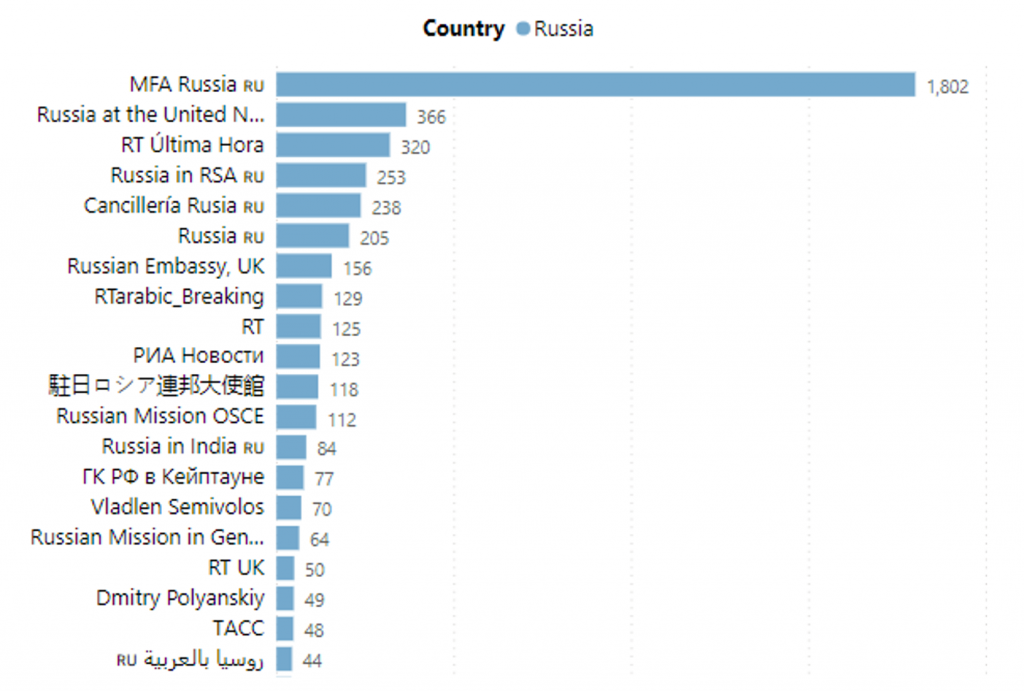
Figure 4: Monitored Russian media and diplomatic/government accounts most retweeted by other monitored Russian media and diplomatic/government accounts in July 2022.
The Russian Ministry of Foreign Affairs (MFA) continued to be the most retweeted account by monitored accounts. And while the account for Russia’s Mission to the United Nations remained the second most retweeted, the number of times it was amplified by other Russian accounts fell from 531 in June to 366 in July. The UN diplomat Dmitry Polyanskiy saw an even steeper decline in retweets by other Russian propagandists, with Polyanskiy’s retweets dropping from 127 in June to 49 in July. Kremlin-linked accounts’ lack of support for these two UN-related messengers is odd given Russia’s usual eagerness to use the UN as a forum to spread war-related disinformation.
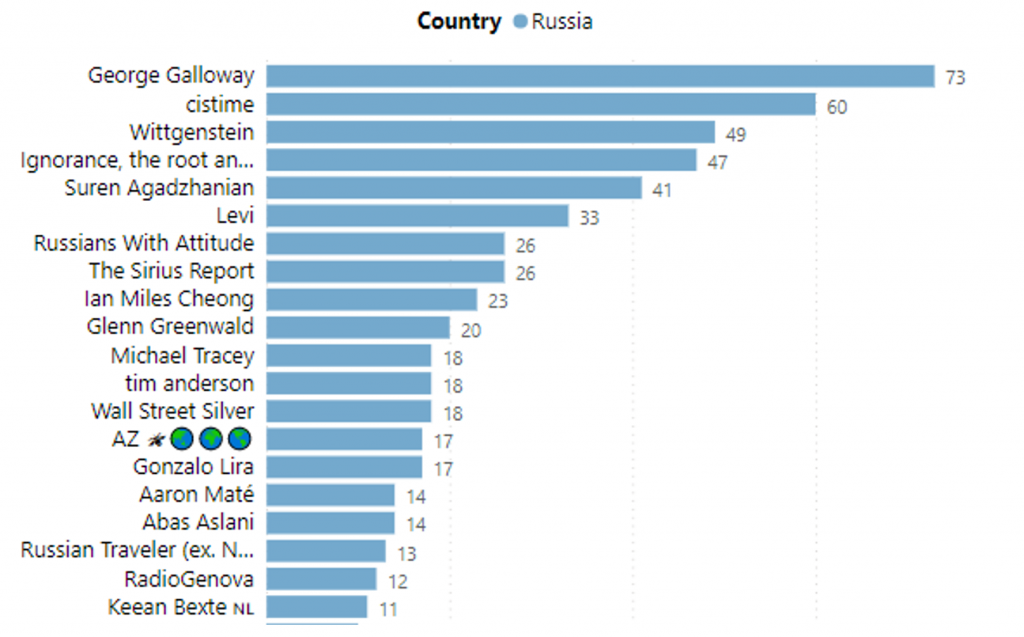
Figure 5: Non-monitored accounts most retweeted by monitored Russian media and diplomatic/government accounts in July 2022.
Russian officials and state-directed media amplified a range of fringe accounts, most of which target English-speaking audiences. Eighteen of the 20 most retweeted non-Russian accounts post primarily in English, which underscores how intermeshed Russia’s propaganda apparatus is with the fringe portions of the English-language information ecosystem. The most retweeted non-Russian accounts range from those operating under the names of 20th century philosophers and pretending to be Dimitry Medvedev’s son to the verified accounts of Glenn Greenwald and Ian Miles Cheong. Generally, the throughline connecting these various accounts is opposition to the Biden administration’s foreign and domestic policies.
Most Retweeted Tweets
The following charts display the Tweets made by monitored accounts that have received the most retweets during the previous month. Non-English Tweets are displayed in English using Microsoft’s Translator API.
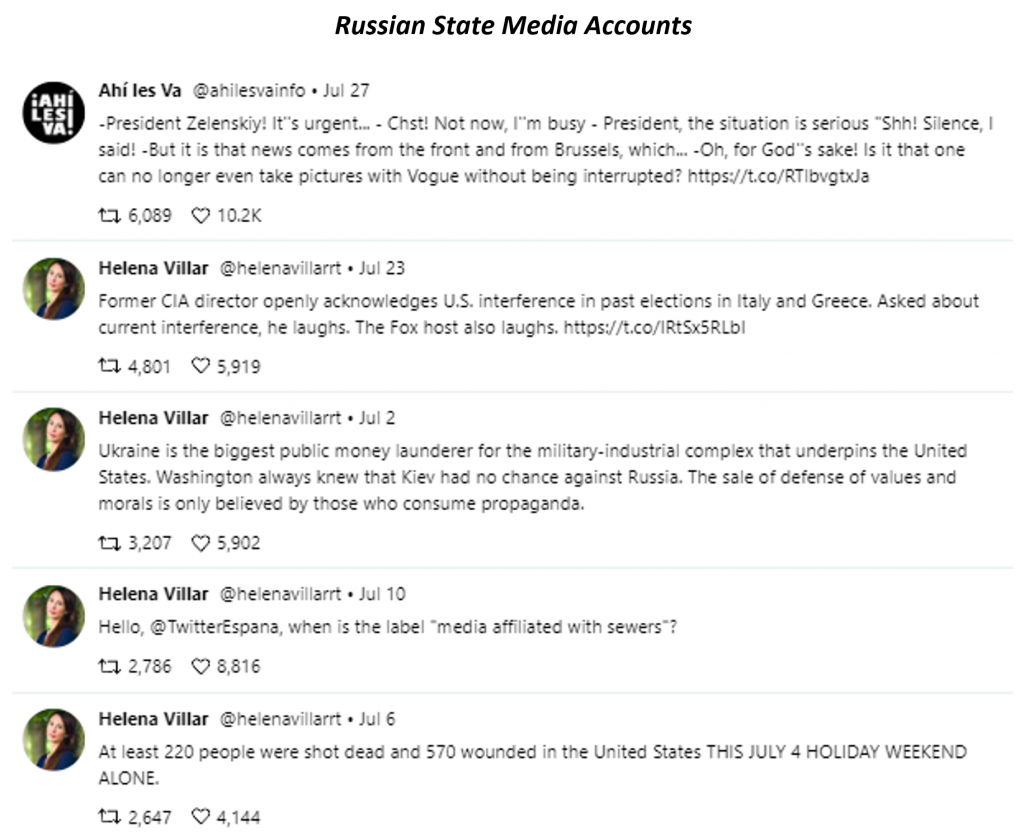
Figure 6: The most retweeted tweets from Russian state media accounts in July 2022.
In July, all five of the most retweeted posts by Russian state media were in Spanish. Four of those tweets came from Helena Villar, an RT en Español correspondent who also gained 2,000 followers last month. The top post came from the RT en Español program Ahi les Va. That tweet gained 6,089 retweets, which is 2,629 more retweets than the top post in June. The top July posts bashed Ukraine, the United States, and social media platforms, which are all common themes in Russian media.
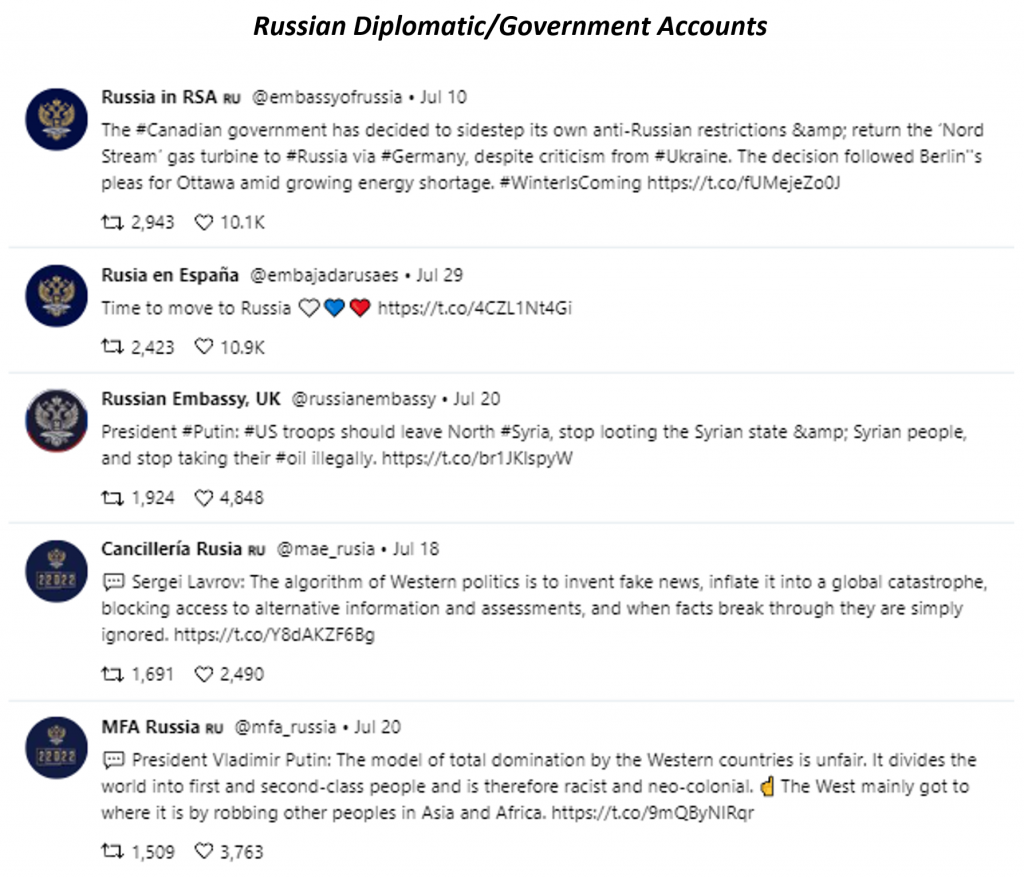
Figure 7: The most retweeted tweets from Russian diplomatic/government accounts in July 2022.
The top diplomatic posts from July were predictably anti-Western and pro-Russian, with the second most retweeted post linking to a video that urged people to move to Russian to enjoy cheap energy, beautiful women, vodka, and a lack of cancel culture. The top performing diplomatic post in July, though, only brought in around a third of the retweets that the top diplomatic post generated in June. The usually popular Japanese Embassy didn’t send a top five tweet this month.
Facebook Metrics
This section provides a summary analysis of Russian state media and diplomatic/government Pages on Facebook during the previous month. Data is sourced from CrowdTangle, a Facebook-owned data analysis tool that provides insights into public content posted to Facebook. (NOTE: CrowdTangle data will be incorporated into the public dashboard in the summer of 2022.)
Most Interactions
The following chart displays the Russian state media and diplomatic/government Pages on Facebook with the most interactions (reactions, comments, and shares) during the previous month. Though sorted by interactions, the chart also displays the average number of posts per day, page followers, and interaction rates (a calculation of total interactions divided by the number of posts and the number of followers of a Page), all of which are important metrics to contextualize the results.
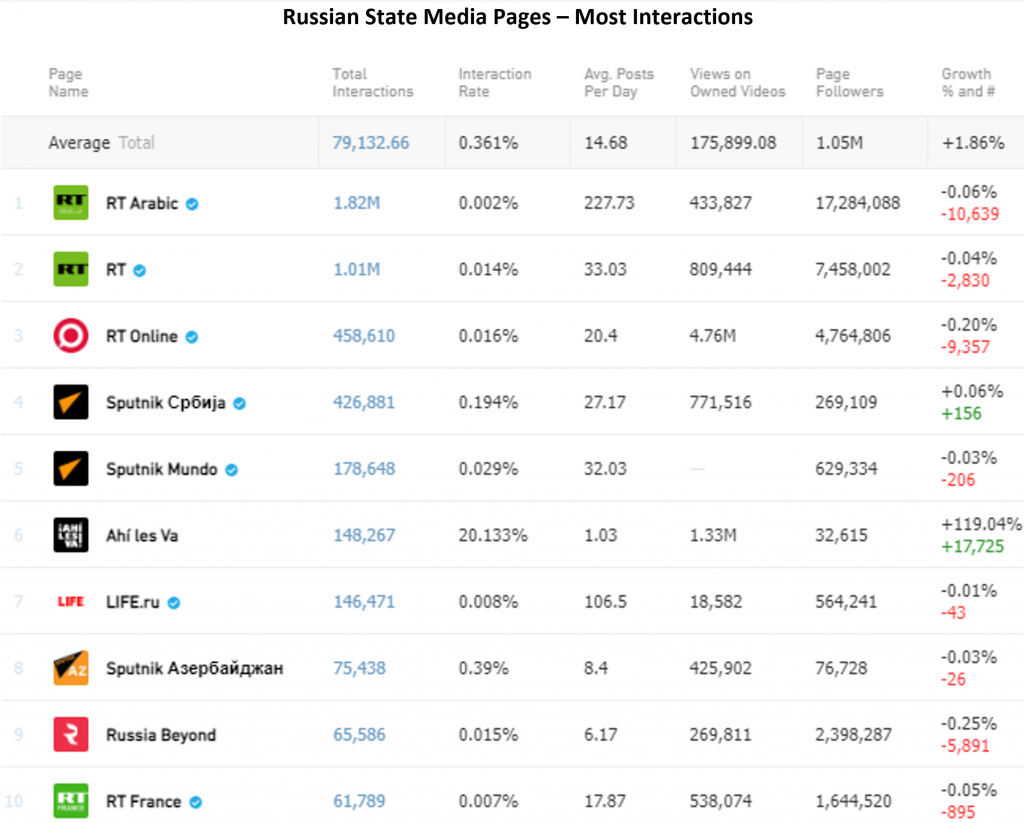
Figure 10: Russian state media pages with the most total interactions on Facebook in July 2022.
ASD began tracking several new Russian state media Facebook pages in July, which makes overall comparisons to previous months difficult. However, a review of individual pages shows some top accounts slowly rebuilding their interaction rates, while others continue to decline.
RT Arabic, the Kremlin’s most successful Facebook page, had 1,820,000 total interactions in July, which is 70,000 more than it had in June but still 680,000 less total interactions that had in May. RT’s page followed a similar route. RT earned 1,010,000 total interactions in July, which is up from its June numbers but not on par with its May figures. Sputnik Serbia, though, saw a significant jump in engagement. In July, the page earned 426,881 total interactions—a 60 percent increase from the previous month.
Several other accounts continued to lose interactions. RT France, for example, saw its interactions drop from 103,829 in June to 61,789 in July, which reflects the EU’s ban on state media. Sputnik Mundo, a page that drew attention from US lawmakers in July, also saw a large month-over-month drop. It fell from 228,656 total interactions in June to only 178,648 in July.

Figure 11: Russian diplomatic pages with the most total interactions on Facebook in July 2022.
The average total interactions with Russian government pages on Facebook rebounded somewhat in July from their steep drop in June. Average interactions increased from 7,957 in June to 9,326 in July. Russia’s Embassy in Bangladesh was the biggest winner, jumping from around 15,000 interactions in June to more than 61,000 interactions in July. Other pages largely held steady.
Pages with the Largest Percentage Growth in Followers
The following chart displays the Russian state media and diplomatic/government Pages with the largest percentage growth in followers during the previous month.
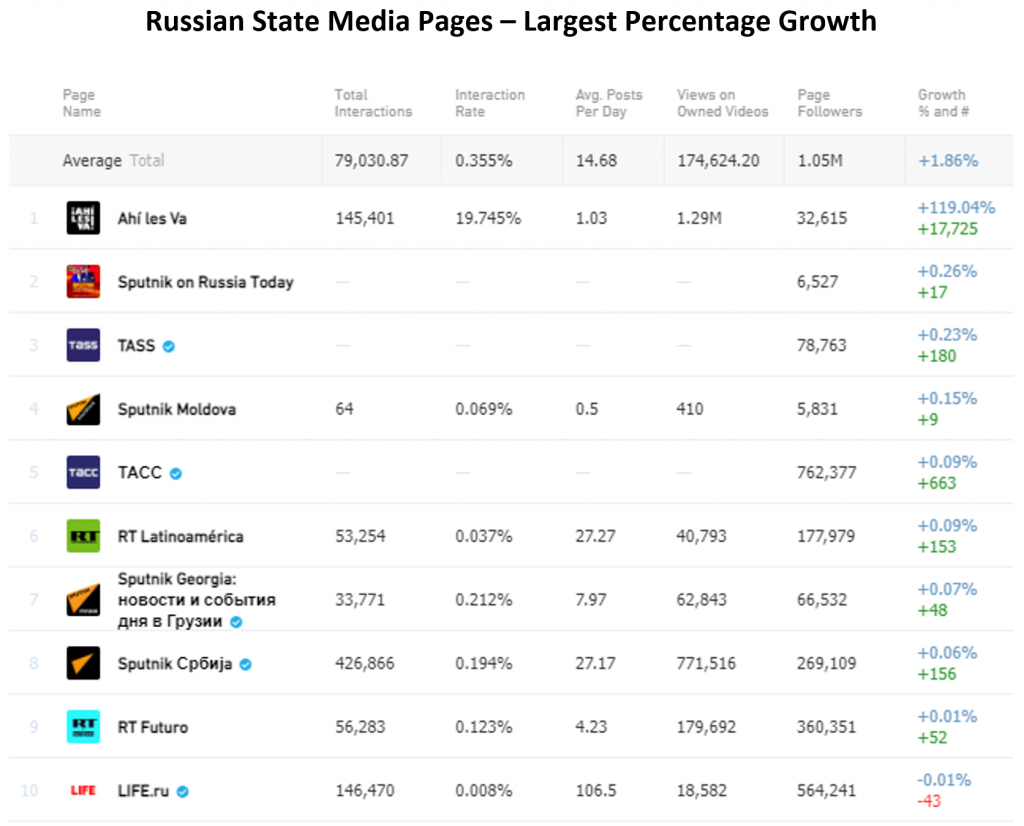
Figure 12: Russian state media pages with the largest percentage growth in followers on Facebook in July 2022.
Ahi les Va saw the biggest jump in followers in July. Ahi les Va’s Facebook page was created in 2019 but didn’t begin posting content until February 17, three days before Russia’s invasion of Ukraine. Facebook has not labeled Ahi les Va’s page as state media. Outside of Ahi les Va, there were no Kremlin-linked accounts that saw large follower increases. Fifty-two of 61 monitored media pages lost followers in July.
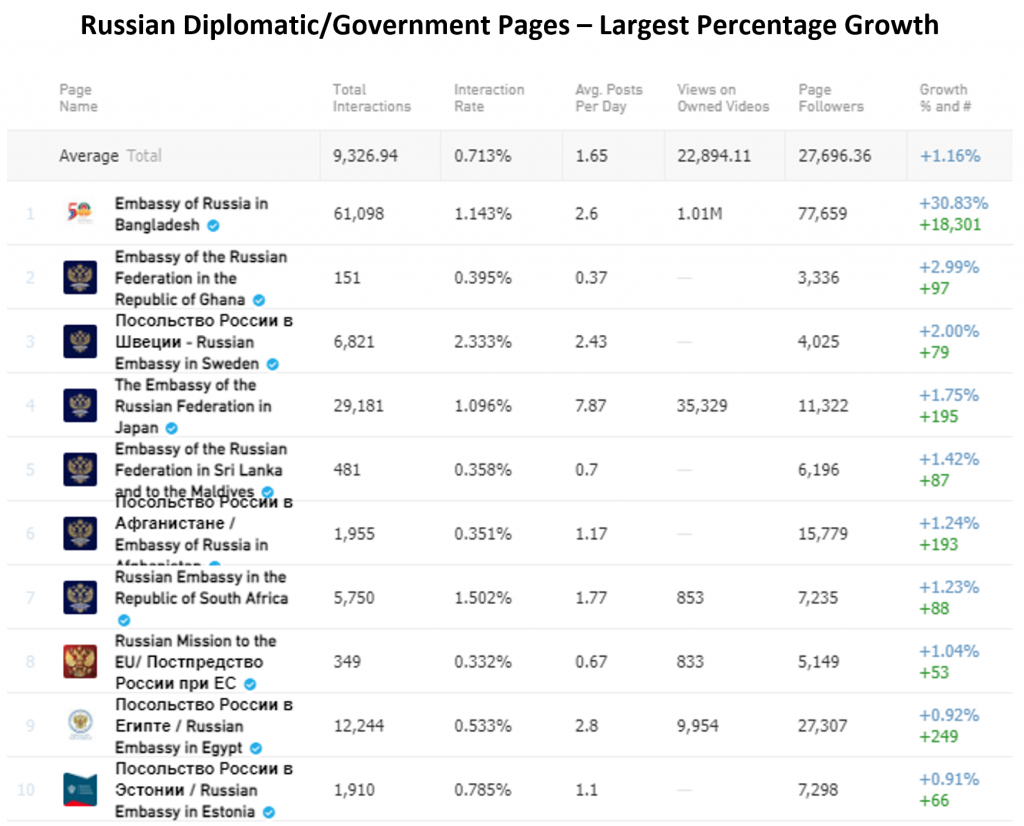
Figure 13: Russian diplomatic and government pages with the largest percentage growth in followers on Facebook in July 2022.
Russian government Facebook pages continued to build their audiences in July. Thirty-eight out of 47 monitored diplomatic pages added followers. The Embassy in Bangladesh brought in 18,301 new followers last month, making it the fastest growing diplomatic page. The Bangladesh Embassy’s follower increase was even larger than the fastest growing state media account.
Most Commented Posts (By Total Interactions)
The following posts received the most comments on Russian state media and Russian diplomatic/government Facebook Pages during the previous month. Posts are segmented by all Russian state media pages, Russian state media Pages specifically targeting audiences in the United States, and Russian diplomatic/government Pages.

Figure 14: The top two most commented-on posts on Russian state media Pages in July 2022.
The top two state media posts on Facebook were in Spanish and Arabic, which highlights the success that Russian propagandists enjoy when posting in those languages. Unsurprisingly, both posts dealt with issues around the current war.

Figure 15: The top two most commented-on posts on Russian state media U.S.-focused Pages in July 2022.
Redacted Tonight was the only US-focused Russian media page that was active on Facebook in July. Its top post earned 36 reactions.

Figure 16: The top two most commented-on posts on Russian diplomatic/government Pages in July 2022.
The top two diplomatic posts were generally uncontroversial. The first post encouraged people to move to Russia, and the second post highlighted Russian President Vladimir Putin’s statement on Eid al-Adha.
China
Twitter Metrics
This section analyzes the top accounts affiliated with and outputs from Chinese state media and diplomatic/government Twitter accounts in July 2022. Non-English Tweets are displayed in English using Microsoft’s Translator API. Engagement metrics are determined using Twitter’s public API and are up to date as of early August 2022.
In total, monitored Chinese accounts tweeted 90,377 times in July. Those Tweets were retweeted and liked, respectively, 605,853 and 2,403,911 times during the month. While the number of likes and retweets increased slightly, the total number of tweets dipped by almost 5 percent compared to totals in July.
Most Retweeted Accounts
The following charts display the most retweeted Chinese state media and Chinese diplomatic/government accounts during the past month. Favorites and total tweets are also displayed.

Figure 17: The most retweeted and liked Chinese state media (left) and diplomatic/government accounts (right) in July 2022.
The list of most influential Chinese diplomatic and state media Twitter accounts remains quite consistent from one month to the next. On the state media side, tweets from Chen Weihua, the combative head of China Daily in Europe, were retweeted 50 percent less and liked about 30 percent less in July than in June. The other two state media personalities in the top ten, CGTN commentator Shen Shiwei and Global Times former editor-in-chief Hu Xijin, did remarkably well considering how little they tweeted compared to the other Chinese state media accounts.
On the diplomatic side, the top ten remained largely unchanged from the previous month, with Zhang Meifang, the consul general in Belfast, topping the chart for the third month in a row. The top five are the same diplomats, in the same order, as in June. In the second half of the top ten, Xie Yong Jun, an official in the Chinese Ministry of Foreign Affairs’ (MFA) Information Department, dropped out of the ranking, while Li Bijian, the consul general in Karachi and a prolific diplomat on Twitter, reclaimed an even better spot than he occupied in May, when he came in tenth.
Most Followers Gained
The following charts display the state media and diplomatic/government accounts with the largest change in followers from July 1 to July 31, 2022.

Figure 18: The Chinese state media and diplomatic/government accounts with the largest change in followers in July 2022.
On the state media side, individuals continued to outperform institutions, at least in percentage increases. Four of the top five fastest growing accounts belonged to state media personalities, including the already popular Hu Xijin and Chen Weihua. Given that these two employ particularly aggressive rhetoric on the platform, their success confirms an appetite for Beijing’s most confrontational content.
On the diplomatic side, the fastest growing accounts are essentially the most influential ones. The only two exceptions are Chinese Ambassador to the United States Qin Gang, whose account is growing fast despite lagging in engagement numbers, and Yan Yiqiang, a St. Petersburg-based diplomat who consistently generates enough engagement to be in the top ten most influential accounts but whose follower count remains relatively small and stable.
Most Mentioned Countries
The following chart displays the countries most mentioned in Tweets during the past month. Special territories and regions (for example, Hong Kong and the EU) are included as individual entities in the country data. The chart aggregates all mentions of a country, including alternative country names, under that country’s official name (for example, mentions of US, USA, U.S., and America are all included in tabulations for the United States of America).
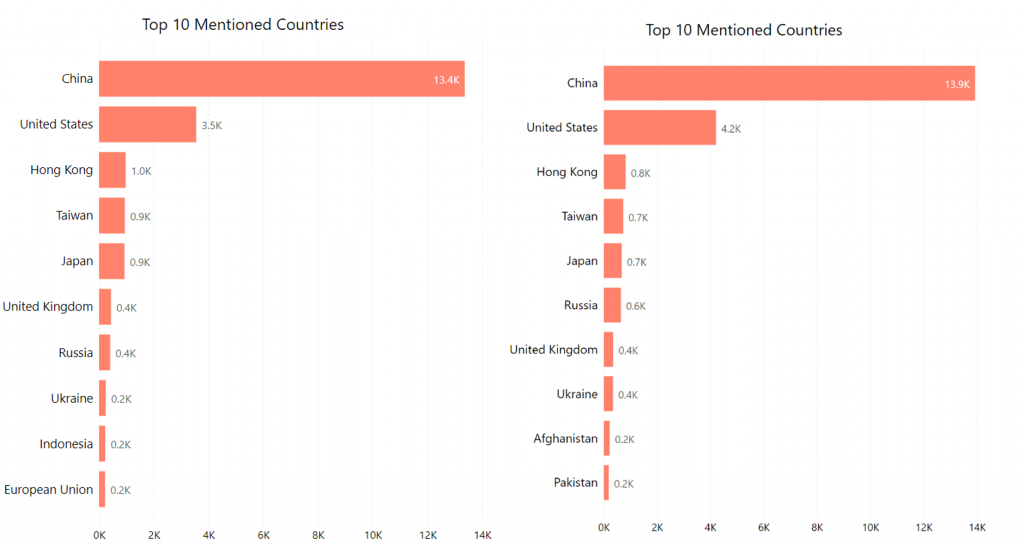
Figure 19: The most mentioned countries in tweets from Chinese state media (left) and diplomatic/government accounts (right) in July 2022.
The most salient trend in July was the renewed interest from both Chinese diplomats and state media in China’s immediate neighborhood, with Hong Kong, Taiwan, and Japan all in the top five most mentioned countries. State media put out almost double the number of Taiwan-related tweets and triple the number of Japan-related tweets in July as compared to June. And while Hong Kong remained the third most mentioned location by both groups of Chinese accounts, state media actually covered the city 30 percent less in July than in June.
Another notable trend was the continued decline of interest in the war in Ukraine, with state media emulating in July the lack of interest Chinese diplomats had already demonstrated last month. Mentions of Russia by Chinese state media were down by around 80 percent, and mentions of Ukraine declined even more steeply.
Finally, Pakistan and Afghanistan’s continued presence in the list of the ten countries most mentioned by diplomats continues to highlight those countries’, and the broader region’s, importance for Chinese interests.
Most Retweeted Accounts
The following charts display the accounts that have been retweeted most often by accounts monitored on the dashboard during the past month. The first chart displays the monitored accounts most retweeted by other monitored accounts (for example, a diplomatic account retweeted by other diplomatic and state media accounts). The second chart displays the non-monitored accounts most retweeted by monitored accounts (for example, an independent media outlet or unaffiliated individual retweeted by diplomatic and state media accounts). Occasionally, accounts that should be monitored by the dashboard appear in the non-monitored retweet list, either because those accounts are new or were not previously identified. Those accounts are subsequently added to the relevant Hamilton account list.

Figure 20: Monitored Chinese media and diplomatic/government accounts most retweeted by other monitored Chinese media and diplomatic/government accounts in July 2022.
The list of Chinese diplomatic and state media accounts that were most retweeted by other diplomats and state media entities remained consistent with the list of the most retweeted Chinese accounts overall. The consul general in Karachi went from tenth in June to second in July, matching the data observed in the most influential accounts list. As was the case in June, Zhang Meifang was the most retweeted account, with a 30 percent increase in retweets in July.
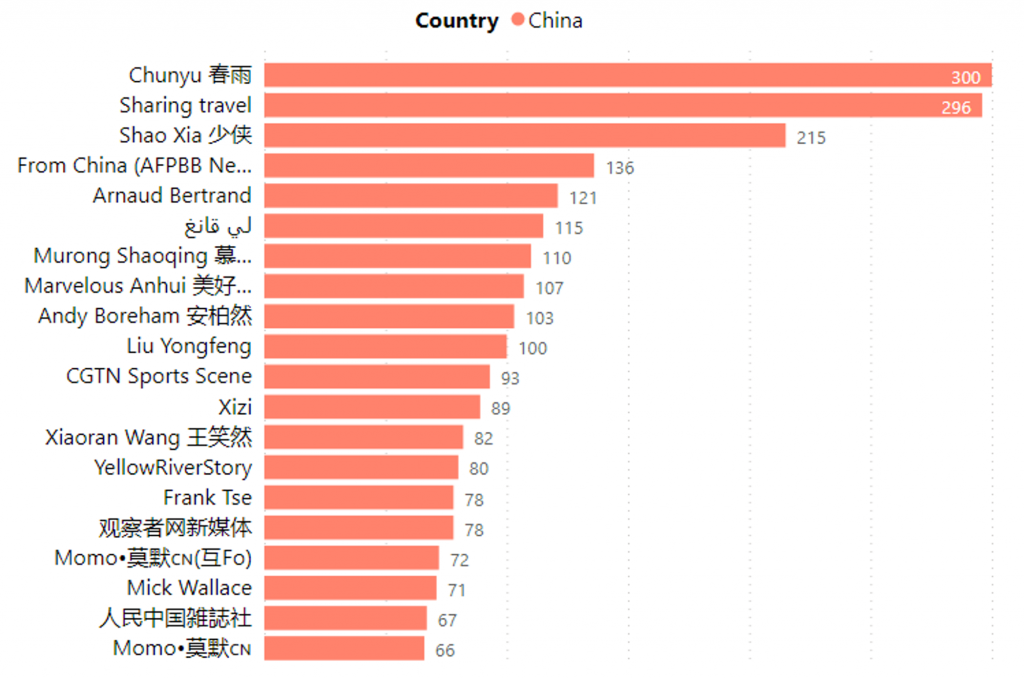
Figure 21: Non-monitored accounts most retweeted by monitored Chinese media and diplomatic/government accounts in July 2022.
The prominence of several Western influencers in the list of non-monitored accounts that Chinese media and diplomatic/government accounts retweeted in July made this graph look rather different from the one in June. In particular, New Zealander Andy Boreham and Frenchman Arnaud Bertrand stood out as pro-Chinese Communist Party (CCP) voices who purport to explain the truth about China that Western media and politicians supposedly obfuscate. Another notable account in this list is Member of the European Parliament Mick Wallace, an Irish elected official whose rhetoric naturally aligns with Chinese diplomats and state media’s narratives.
Most Retweeted Tweets
The following charts display the Tweets made by monitored accounts that have received the most retweets during the previous month. Non-English Tweets are displayed in English using Microsoft’s Translator API.
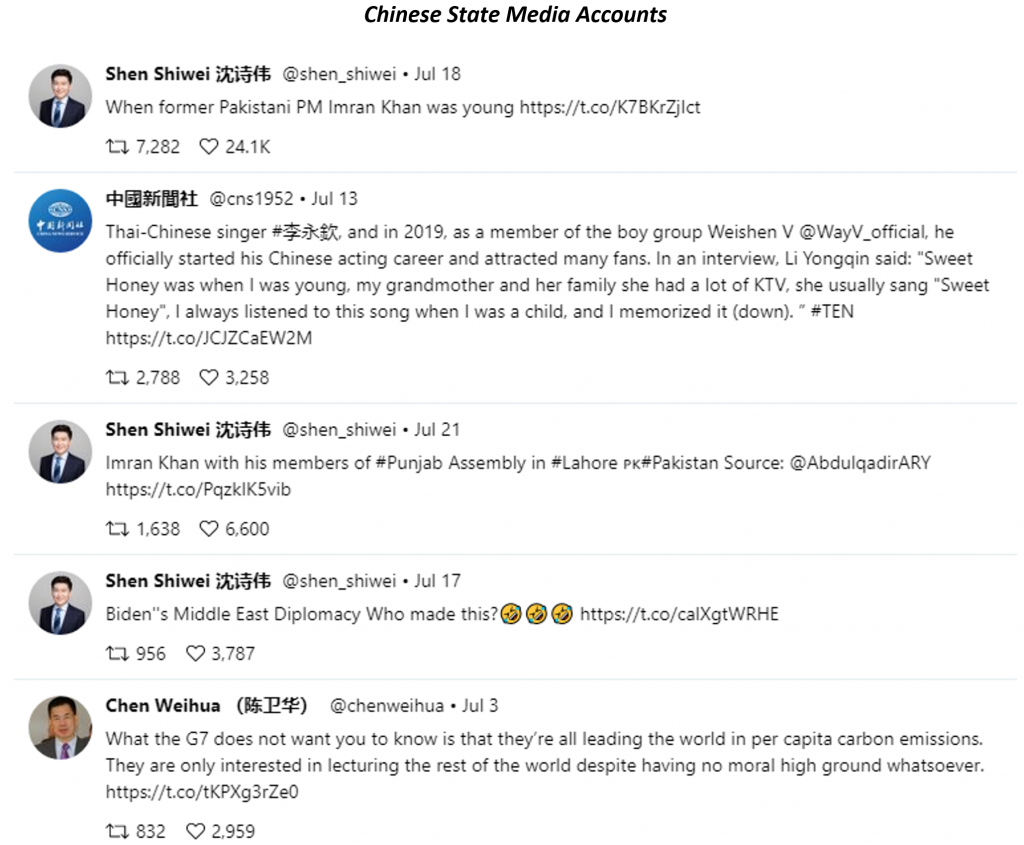
Figure 22: The most retweeted tweets from Chinese state media accounts in July 2022.
In July, CGTN personality Shen Shiwei authored three of the five most retweeted tweets from Chinese state media accounts. The first and third tweet on this list reflected the special relationship with Pakistan that was already alluded to in previous monthly reports. The fourth and fifth tweet above highlighted the consistent anti-Western messaging coming from various parts of the network of Chinese accounts monitored on Hamilton 2.0.

Figure 23: The most retweeted tweets from Chinese diplomatic/government accounts in July 2022.
The five most retweeted tweets from Chinese diplomats in July were even more critical of the United States and its democratic allies. Three of the above tweets went after the United States directly, leaning in particularly strongly on the superpower’s history of military interventionism abroad. The other two questioned the representativeness of the current international system of governance and criticized the United Kingdom to score points over Hong Kong.
YouTube Metrics
This section summarizes the outputs of video content uploaded to CGTN and CGTN America’s YouTube channels. YouTube videos over 20 minutes in length were not included. In total, the dashboard collected 483 videos that garnered 1,107,924 views, 13,863 comments, and 33,647 likes (engagement metrics are accurate as of early August).
Most Viewed Videos
The following chart displays the most viewed videos posted to CGTN and CGTN America’s YouTube channels over the previous month. Additional engagement metrics including likes, dislikes, and comments are also provided. Engagement metrics are accurate as of early August.
|
Title |
Outlet |
Date |
Views |
Likes |
Dislikes |
Comments |
|
Two-handed Sword’s uniqueness lies in dexterity |
CGTN |
7/17 |
460,009 |
170 |
|
21 |
|
Building Lives – Ep. 4: A center of hope and new life |
CGTN |
7/4 |
295,695 |
29 |
|
2 |
|
Xingyi Quan, imitating the movement of the spear |
CGTN |
7/5 |
283,469 |
84 |
|
13 |
|
The Point: Exclusive with Sally Yeh |
CGTN |
7/6 |
263,396 |
5,039 |
|
446 |
|
Kabul Taliban police get new uniform |
CGTN |
7/3 |
188,302 |
3,859 |
|
1,257 |
|
Deadly air show accident in Michigan |
CGTN America |
7/2 |
178,428 |
720 |
|
373 |
|
We talk: Why I am against NATO |
CGTN |
7/1 |
117,565 |
5,822 |
|
2,036 |
|
A sea gate connecting the world |
CGTN |
7/12 |
86,660 |
118 |
|
10 |
|
Vladimir Putin attends military parade in Saint Petersburg |
CGTN |
7/31 |
74,833 |
1,916 |
|
590 |
|
Xi Jinping’s visit to Xinjiang |
CGTN |
7/16 |
54,866 |
1,984 |
|
441 |
Something rather unusual happened with the top ten most viewed videos by Chinese state media on YouTube in July. The top three videos, as well as the eighth video, in this list exhibit very odd statistics with far lower engagement numbers than one would expect given the number of views they garnered. Given the relatively innocuous subjects of those videos, with two of them talking about martial arts and the other two promoting Chinese infrastructure projects, it will take more data, and the possible re-occurrence of this anomaly in future months, to fully understand what is happening with CGTN’s YouTube channel.
The story about Taliban police officers’ new uniforms echoes Chinese diplomats’ sustained interest in Afghanistan on Twitter.
Most Mentioned Countries
The following chart displays the countries most mentioned in CGTN and CGTN America videos during the past month. Country data is extracted from titles and excerpts posted to each video on YouTube, meaning that countries that are referenced in a video segment but that do not appear in the description or title will not be included.
Special territories and regions (for example, Hong Kong and the EU) are included as individual entities in the country data. The chart aggregates all mentions of a country, including alternative country names, under that country’s official name (for example, mentions of US, USA, U.S., and America are all included in tabulations for the United States of America).
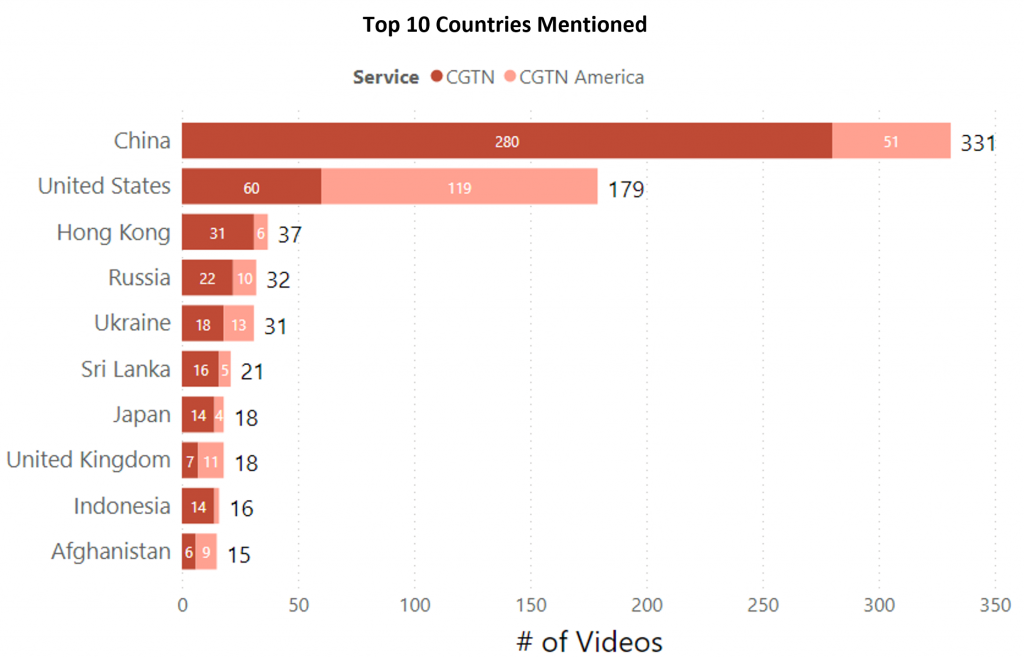
Figure 24: The most mentioned countries in CGTN (dark red) and CGTN America (pink) videos in July 2022.
Unlike on Twitter, Russia and Ukraine still featured prominently in the list of countries most mentioned in Chinese state media’s video content.
Sri Lanka was also rather prominent as the South Asian island underwent a popular uprising in July that caused some embarrassment for Beijing, one of the country’s main creditors. While several videos related to the island covered the unrest, the most viewed one focused on Chinese aid to the country. Another focused on the positive effects of Chinese infrastructure projects that have come under attack for placing an excessive debt burden on Sri Lanka.
Top Categories
The following chart displays the news categories covered most often in CGTN and CGTN America YouTube videos during the previous month. Classification of videos is determined by a machine learning algorithm based on a list of pre-determined news categories. Videos can have multiple classifications or no classifications if the confidence score is below a certain threshold.
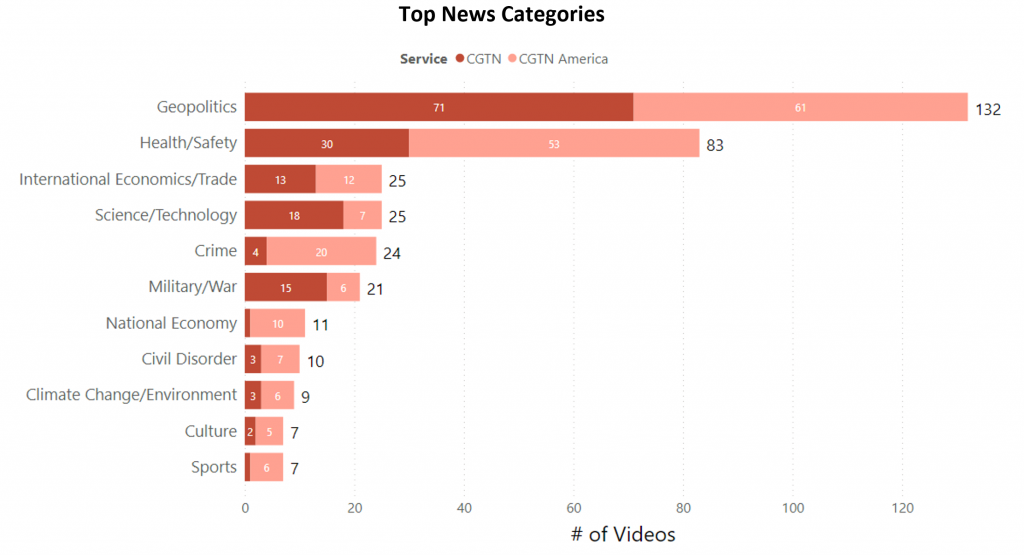
Figure 25: The top news categories for CGTN (dark red) and CGTN America (pink) in July 2022.
Chinese state media-produced video content related to geopolitics almost doubled in July compared to June on both CGTN and CGTN America, as Chinese messaging was priming their audience for China’s strong reaction to US Speaker of the House Nancy Pelosi’s then-hypothetical trip to Taiwan. However, the amount of video content related to military/war remained the same in June and July.
Facebook Metrics
The following chart displays the Chinese state media and diplomatic/government Pages on Facebook with the most interactions (reactions, comments, and shares) during the previous month. Though sorted by interactions, the chart also displays the average number of posts per day, page followers, and interaction rates (a calculation of total interactions divided by the number of posts and the number of followers of a Page), all of which are important metrics to contextualize the results.
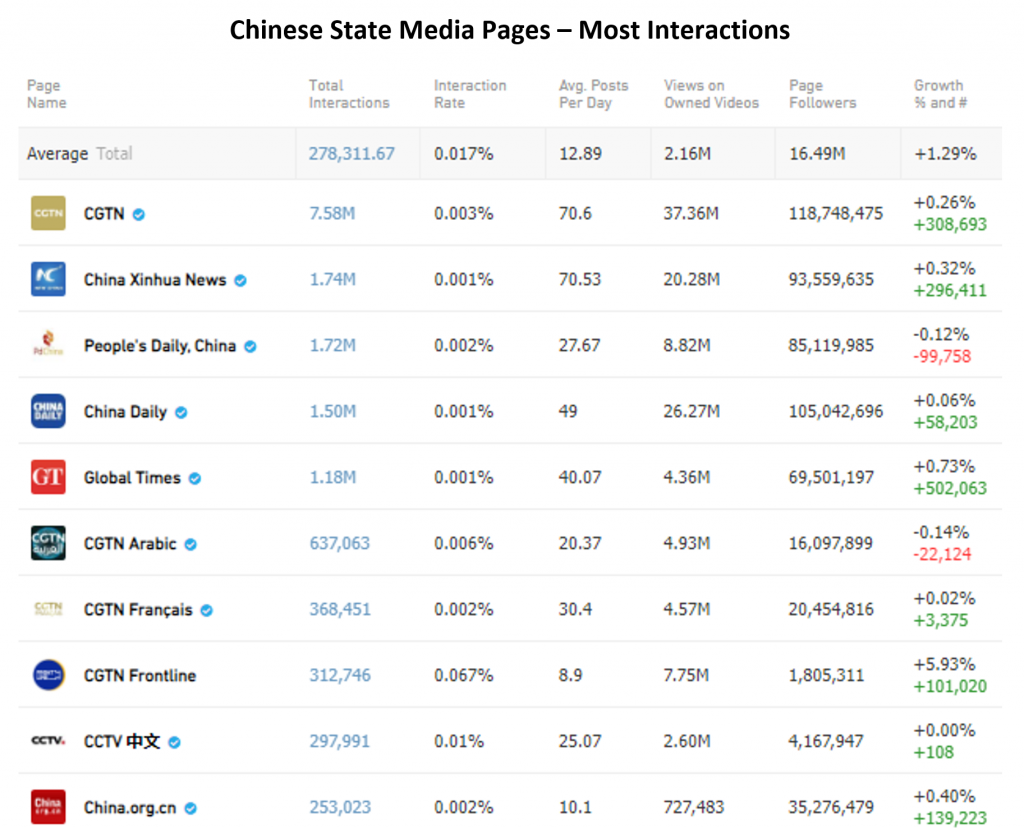
Figure 26: Chinese state media pages with the most total interactions on Facebook in July 2022..
Average total interactions with Chinese state media pages on Facebook dropped by more than 25 percent in July as compared to June. The fall was especially noticeable for CGTN, which was down more than 20 percent; Xinhua, with a more than 30 percent drop; and China Daily, with an almost 50 percent decrease in total interactions. The drop in interactions was particularly severe in China Daily’s case as they produced virtually as much content in both months.
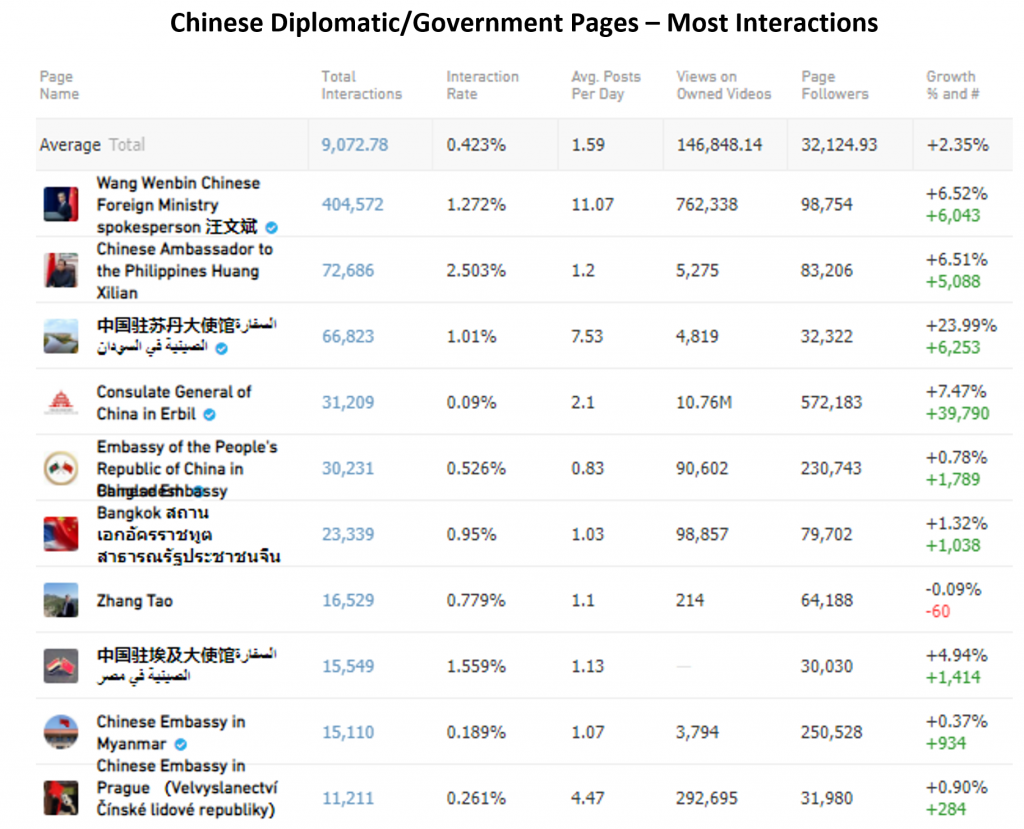
Figure 27: Chinese diplomatic pages with the most total interactions on Facebook in July 2022.
Wang Wenbin, the MFA’s least combative spokesperson, remained the prime mover and shaker among Chinese diplomats on Facebook. The Chinese Consulate in Erbil, Iraq continued to stand out with another month of outstanding growth. In addition, it managed to double its interaction rate in July as compared to June, possibly undermining earlier reports’ theory that part of its large and rapidly growing follower count could be inauthentic.
Pages with the Largest Percentage Growth in Followers
The following chart displays the Chinese state media and diplomatic/government Pages with the largest percentage growth in followers during the previous month.

Figure 28: Chinese state media pages with the largest percentage growth in followers on Facebook in July 2022.
CGTN Frontline, one of Chinese state media’s more tabloid-esque outlets, continued to grow at an exceptional rate in July, gaining the most followers in absolute terms. Because Xinhua North America’s page was created in 2017, its rapid growth almost five years later is something to watch out for.
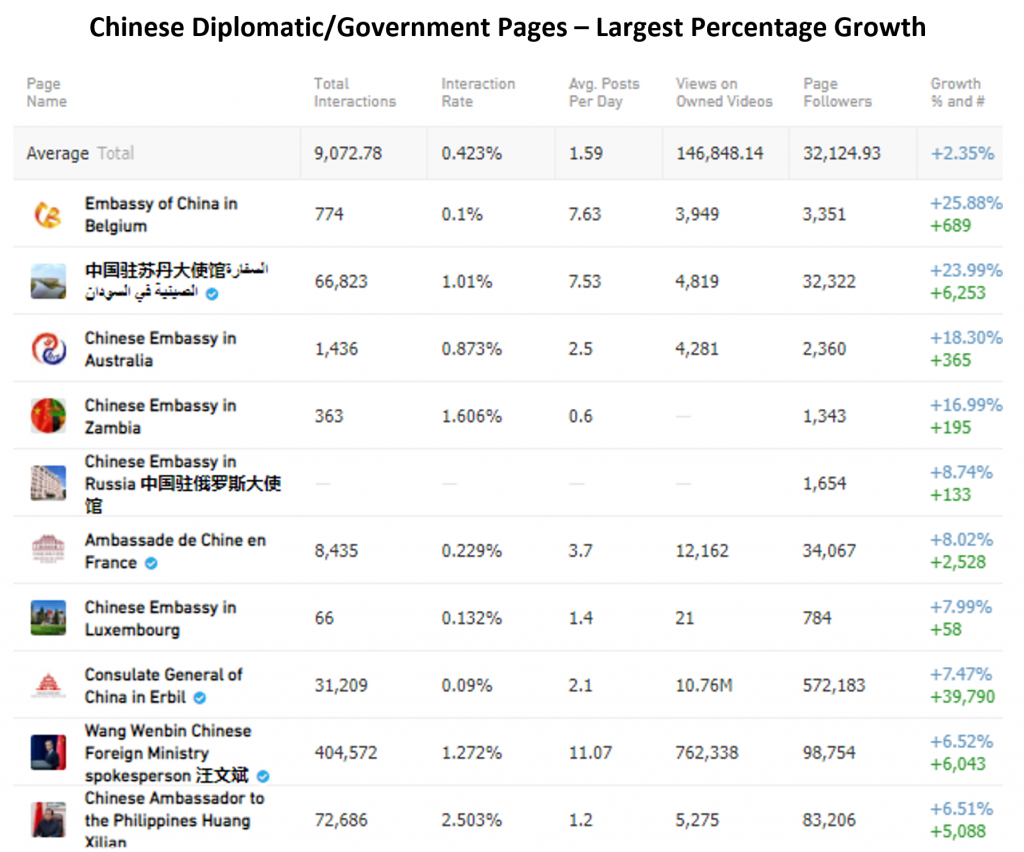
Figure 29: Chinese diplomatic and government pages with the largest percentage growth in followers on Facebook in July 2022.
The Chinese Embassy in Sudan maintained its high level of follower growth, both in percentage as well as in absolute numbers. In Europe, the Embassy in Belgium may have been the fastest growing page in July, but it grew relatively slowly in absolute numbers. Meanwhile, the Embassy in France has consistently gained thousands of new followers each month since May. The Chinese Embassy in South Africa went from being one of the fastest growing Chinese pages on Facebook in June to losing followers in July.
Most Commented Posts (By Total Interactions)
The following posts received the most comments on public Chinese state media and Chinese diplomatic/government Facebook Pages during the previous month. Posts are segmented by all Chinese state media pages, Chinese state media Pages specifically targeting audiences in the United States (for example, CGTN America), and Chinese diplomatic/government Pages.
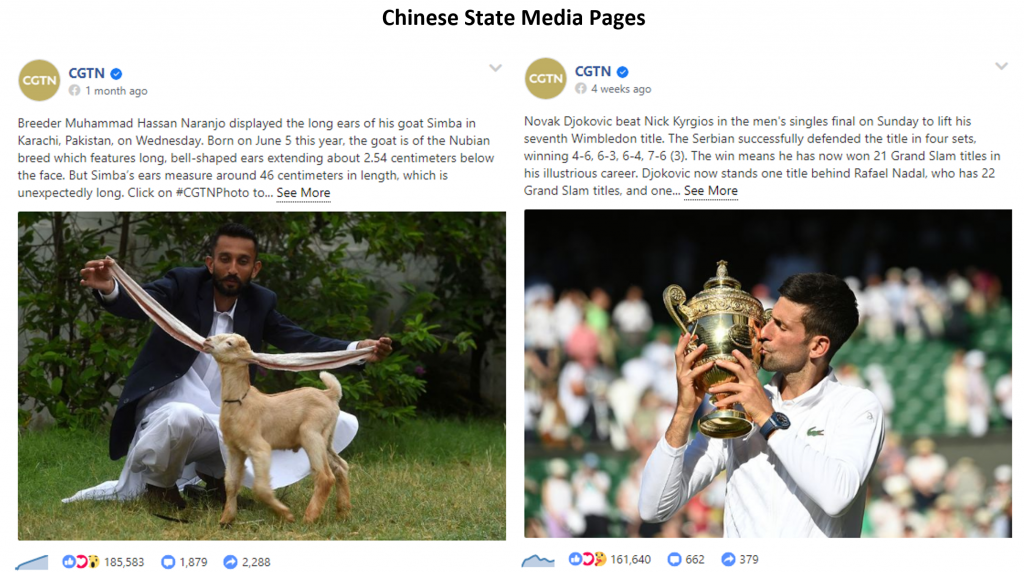
Figure 30: The top two most commented-on posts on Chinese state media Pages in July 2022.
As was the case in June, the most popular piece of content put out by Chinese state media in July was a clickbait-style video that had the potential to go viral and capture audience share. China’s cultivation of close ties to Serbia potentially makes Chinese state media’s coverage related to Novak Djokovic’s victory at Wimbledon more significant than other sports-related news.

Figure 31: The top two most commented-on posts on Chinese state media U.S.-focused Pages in July 2022.
Chinese US-focused pages showed that the United States benefitted from sanctions against Russia, implicitly underlining the point that Europe is being taken advantage of. They also relayed news about the high-profile conversation between Presidents Joe Biden and Xi Jinping.

Figure 32: The top two most commented-on posts on Chinese diplomatic/government Pages in July 2022.
The top diplomatic post in July demonstrated how Chinese diplomats grow their presence on social media. The Chinese Embassy in the Philippines contest, offering a Huawei television as a first prize, encouraged users to post pro-Chinese content, for instance about how TikTok is “pop culture that has been shared by the Chinese people to every Filipino,” on Facebook, TikTok, and YouTube.
Iran
Twitter Metrics
This section analyzes the top accounts affiliated with and outputs from Iranian state media and diplomatic/government Twitter accounts in July 2022. Non-English Tweets are displayed in English using Microsoft’s Translator API. Engagement metrics are determined using Twitter’s public API and are up to date as of early August 2022.
In total, monitored Iranian accounts tweeted 20,095 times in July. Those Tweets were retweeted and liked, respectively, 125,226 and 608,721 times during the month.
Most Retweeted Accounts
The following charts display the most retweeted Iranian state media and Iranian diplomatic/government accounts during the past month. Favorites and total tweets are also displayed.

Figure 33: The most retweeted and liked Iranian state media (left) and diplomatic/government accounts (right) in July 2022.
The volume of tweets from monitored Iranian accounts declined very slightly from June, as did engagement. Supreme Leader Ayatollah Khamenei’s accounts remained the most engaged with, but he tweeted slightly less often than the previous month and garnered slightly less engagement. Among his most popular tweets was one criticizing NATO and accusing “westerners” of opposing a “strong and independent Russia.”
Substantial changes on the media side reflect the inclusion of accounts newly designated as Iranian state-affiliated media. The most prominent of these is Chris Williamson, a former Labour MP from Derby, England, who now hosts Palestine Unclassified on Press TV. Another addition is David Miller, a former professor at Bristol University fired over antisemitic remarks, who is a producer on Palestine Declassified and frequently appears as a guest. The most engaged with tweets on each of their accounts consisted of angry denials of past accusations of antisemitism. Williamson’s show also featured George Galloway as a guest, another former Labour MP who has also faced frequent charges of antisemitism and who is designated by Twitter as Russian state-affiliated media.
Most Followers Gained
The following charts display the state media and diplomatic/government accounts with the largest change in followers from July 1 to July 31, 2022.
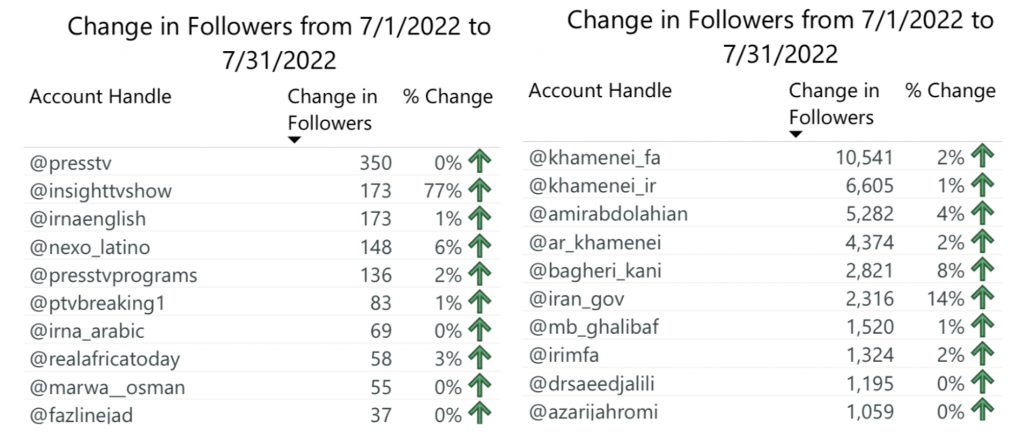
Figure 34: The Iranian state media and diplomatic/government accounts with the largest change in followers in June 2022.
The Iranian government Twitter account, which mostly amplifies statements and comments from the president and the supreme leader, increased its followership substantially during July. Most other government accounts remained stable; although, Ali Bagheri Kani, Iran’s lead nuclear negotiator, has continued to gain followers since his apparent return to Twitter a few months ago.
The followership of media accounts remained stable, except for @insighttvshow, the account of a program on Press TV, that had a significant percent increase in its number of Twitter followers in July.
Most Mentioned Countries
The following chart displays the countries most mentioned in Tweets during the past month. Special territories and regions (for example, Hong Kong and the EU) are included as individual entities in the country data. The chart aggregates all mentions of a country, including alternative country names, under that country’s official name (for example, mentions of US, USA, U.S., and America are all included in tabulations for the United States of America).

Figure 35: The most mentioned countries in tweets from Iranian state media and diplomatic/government accounts in July 2022.
The top countries mentioned by Iranian state-affiliated media and diplomatic accounts remained mostly unchanged from the previous month, reflecting the usual coverage of Israel/Palestine and the war in Ukraine, plus a summit on Syria that brought Russian President Vladimir Putin and Turkish President Recep Tayyip Erdoğan to Iran.
Most Retweeted Accounts
The following charts display the accounts that have been retweeted most often by accounts monitored on the dashboard during the past month. The first chart displays the monitored accounts most retweeted by other monitored accounts (for example, a diplomatic account retweeted by other diplomatic and state media accounts). The second chart displays the non-monitored accounts most retweeted by monitored accounts (for example, an independent media outlet or unaffiliated individual retweeted by diplomatic and state media accounts). Occasionally, accounts that should be monitored by the dashboard appear in the non-monitored retweet list, either because those accounts are new or were not previously identified. Those accounts are subsequently added to the relevant Hamilton account list.
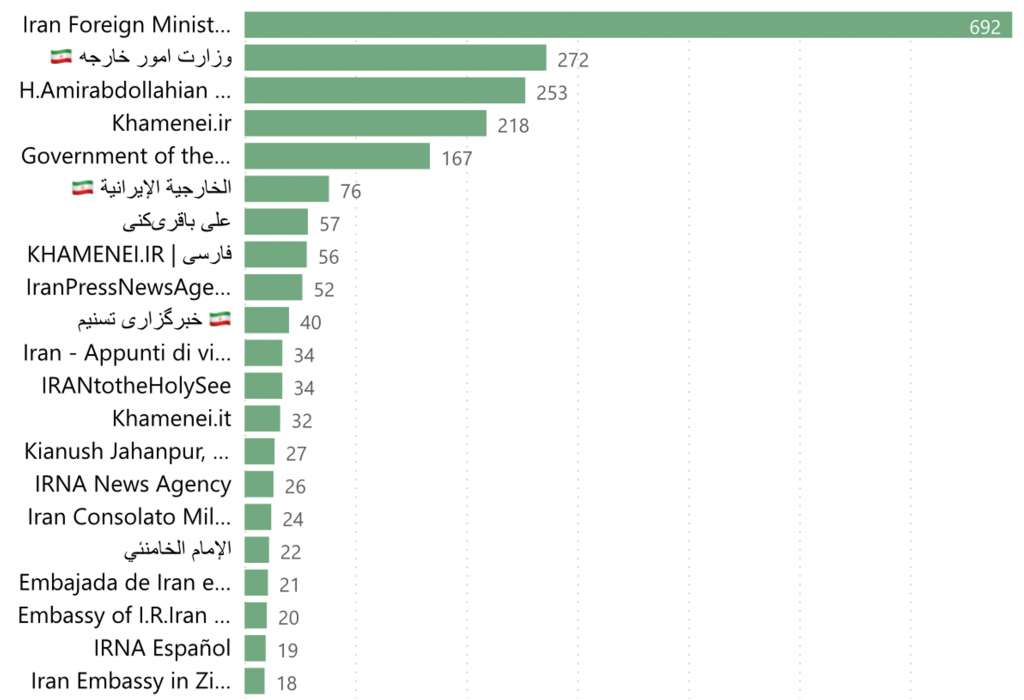
Figure 36: Monitored Iranian media and diplomatic/government accounts most retweeted by other monitored Iranian media and diplomatic/government accounts in July 2022.
The regime-linked accounts most retweeted by other monitored accounts included the foreign ministry, the foreign minister, the supreme leader, and the official government account.
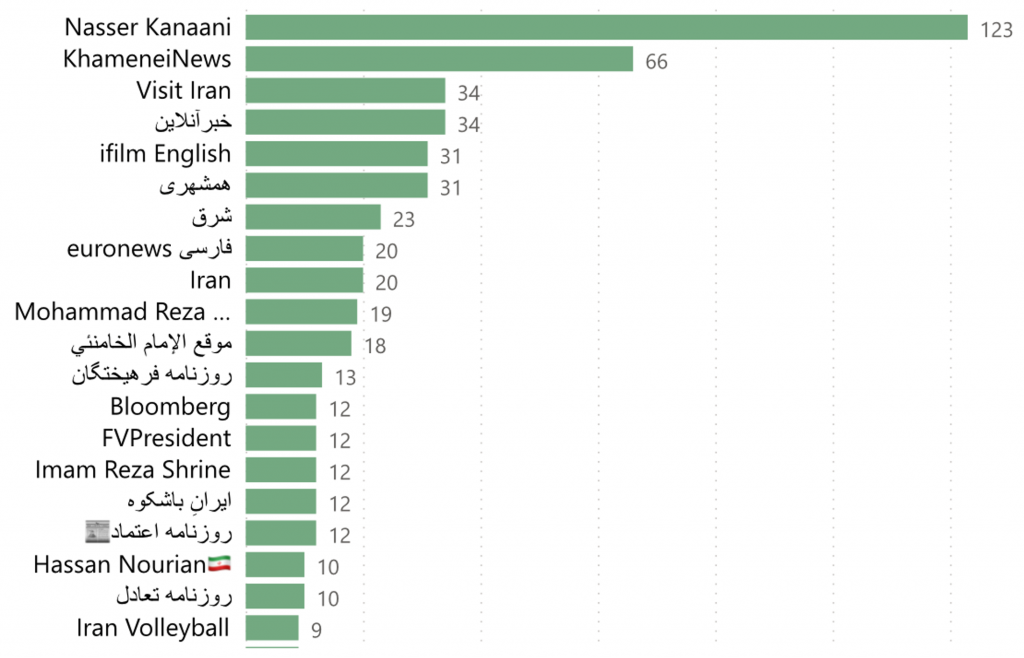
Figure 37: Non-monitored accounts most retweeted by monitored Iranian media and diplomatic/government accounts in July 2022.
The non-monitored accounts most retweeted by monitored Iran-linked accounts included new MFA spokesman Nasser Kanaani, as well as several accounts that promote tourism to Iran.
Most Retweeted Tweets
The following charts display the Tweets made by monitored accounts that have received the most retweets during the previous month. Non-English Tweets are displayed in English using Microsoft’s Translator API.
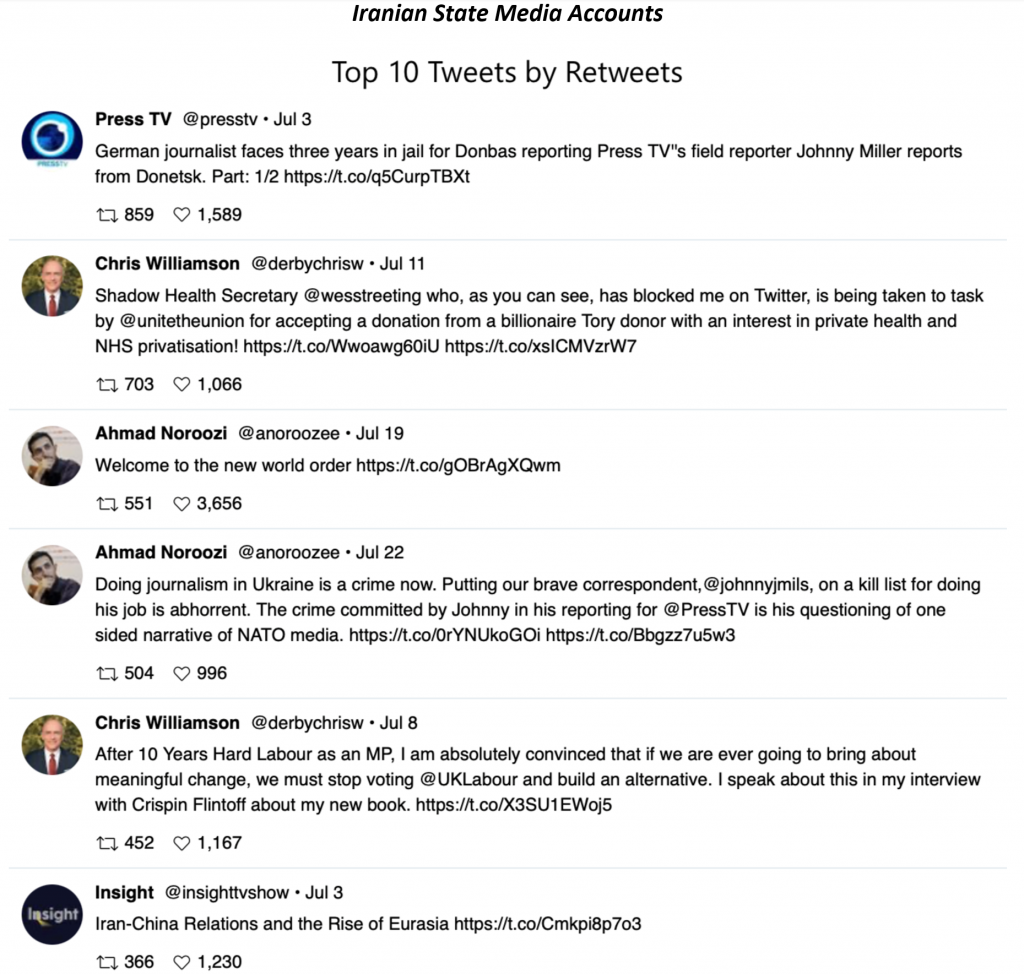
Figure 38: The most retweeted tweets from Iranian state media accounts in July 2022.
The top tweets from Iranian state media-linked accounts accused Ukraine of violating the rights of journalists covering Russia’s invasion. Other popular tweets included Chris Williamson’s criticism of the UK Labour Party.

Figure 39: The most retweeted tweets from Iranian diplomatic/government accounts in July 2022.
All the most retweeted tweets from government accounts came from Khamenei except for one, which came from the government Twitter account. Most of these tweets focused on reducing the influence of the US dollar in global trade and commerce.
YouTube Metrics
The Hamilton Dashboard currently does not track any Iranian state media outlets on YouTube.
Facebook Metrics
Due to restrictions on Iranian state media and diplomatic Pages on Facebook, the few Iranian properties that exist on the platform receive negligible interactions. As a result, we did not conduct analysis of Iran’s Facebook performance.
The views expressed in GMF publications and commentary are the views of the author alone.

